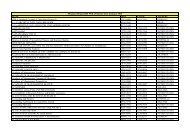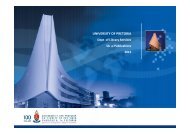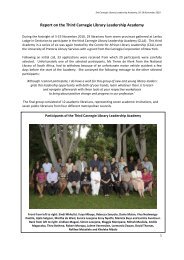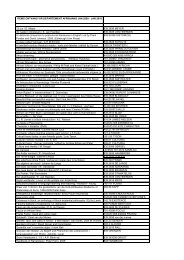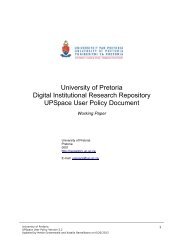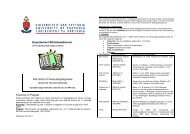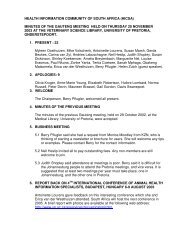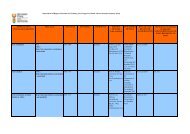Presentation tips - Library
Presentation tips - Library
Presentation tips - Library
You also want an ePaper? Increase the reach of your titles
YUMPU automatically turns print PDFs into web optimized ePapers that Google loves.
TIPS FOR PREPARING AND DELIVERING PRESENTATIONSThree basic steps Prepare the content Prepare the visuals Deliver a winning presentationPREPARE THE CONTENTRemember Voltaire: The secret of being a bore is to tell allKnow your audienceAny presentation must be geared to your audience. Prepare an audience profile. That will tellyou what kind of a presentation you need to prepare.Who are they?What is their primary question?How much do they know already about the issue, problem or project?How willing are they to hear the message? Is it a command performance, completelyvoluntary or something in-between.Are there any other stakeholders we need to reach with these messages?Who will you audience be?How would the different audience profiles influence the length, content and style ofyour presentation?What should be the content of the presentation?The content of the presentation has three parts: the opening, the body and the close.A strong opening should include a hook to immediately get your audience interested,followed by an overviewThe hook should address directly your understanding of the key question that your audienceis interested in. Refer to your focus group data. Remember, too, that the opening statementis your best chance to establish a rapport with the audience – a personal connection. Itshould also create a sense of urgency.The overview should tell the audience what they are about to hear. Set it out like theoutlines of a story – the story they are about to hear. The overview is a roadmap to thebody of your presentation.The body is the key to giving your audience an understanding and appreciation of yourproject. The body should have a logical structure. It should be broken down into parts thatfit together. However, keep is simple. Prioritise and consolidate. Most audiences won’tremember more than three things about a given subject. Here are the elements that shouldgo into the body of the presentation.
Background. This puts the audience on an equal footing with the speaker and will be requiredin most but not all cases.A clear problem statement backed by supporting evidence that shows why the problem orneed exists. Again, some audiences may not need a problem discussion. Go back to youraudience profile to determine how much background is needed.The solution to the problem which in this instance will be your project. Here you need to bevery clear about why your project will solve the problem.Evidence that the project will solve the problem.The benefits that will be derived from the project; why the audience should support it.Actions needed to proceed with implementation. In this case, a discussion of the costs andbenefits of a loan.The close should summarize the strengths of the project and reiterate how they solve theproblem and include a proposal for action. It should be smooth and forceful and give theaudience something to remember.VISUALSVisuals can be very helpful in focusing the attention of the audience and giving additional clarityto the presentation. Experience suggests that if a presentation is made without visuals, it needsto be short, with stimulating content, delivered in a very lively style. If visuals are used (and wethink that usually they should be), keep the following points in mind:Visuals should be closely integrated with and supportive on your main pointsThey should be simple and easy to understandMake sure that everyone in the room can see the visualIn explaining visuals, explain (summarize) the whole visual to the audience before explainingits component partsTie your words to the visual with gestures to keep the viewers eyes fixed on the visualGive the audience a few seconds to absorb visuals before proceeding with the presentationDEVLIVER A WINNING PRESENTATIONSome studies suggest that the major element in the success of failure of a presentation is theway it is delivered, so here are some keys to good presentation:Don’t readDon’t hide behind a lectern. It is a barrier to the audience. Come out from behind thelectern when you can to achieve more intimacy with the audience, connect with them andshow them you’re alive and interested in making your points with them.Keep hands away from the body, because this will distract the audience – their eyes willusually follow your hands.Use supporting gestures, but use them in moderation.To achieve the right voice volume, direct the presentation to someone at the back of theroom.
TRAINING TECHNIQUE:PRESENTATIONDescriptionA presentation is an activity conducted by a resource specialist to convey information, theoriesor principles. Forms of presentations can range from straight lecture to some involvement ofthe learner through questions and discussion. <strong>Presentation</strong>s depend more on the trainer forcontent than does any other training technique.UsesTo introduce participants to a new subjectTo provide an overview or a synthesisTo convey facts, statisticsTo address a large groupAdvantagesCovers a lot of material in a short timeUseful for large groupsCan be adapted to any kind of learnerCan precede more practical training techniquesThe lecturer has more control than in other situationsThings to be aware of before you decide to use a lecture Emphasizes one-way communication Is not experimental in approach Learner’s role is passive Lecturer needs skills to be an effective presenter Inappropriate for changing behaviour or for learning skills Learner retention is not as great unless it is followed up with a more practical technique A presentation is common in more formal situationsProcessIntroduce the topic – tell the learners what you’re going to tell themTell them what you want to tell them – present the material using visual aidsSummarize the key points you’ve made –0 tell the learners what you’ve told themInvite the learners to ask questions



